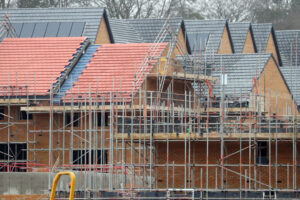New national housing policies could create “large dormitory settlements of commuters” in parts of Derbyshire without investment into infrastructure and jobs, a council says.
A Derbyshire Dales District Council meeting this month debated new planning policies brought by the new Labour Government which could see its housing targets more than doubled from 216 homes per year to 571.
District council officials have dubbed the new policy “disproportionate” and “perverse” and claimed that the new Government needs to drastically change them.
The same plans would see Derby’s home requirements decrease from 1,244 to 1,062, Amber Valley’s annual home requirements rise from 351 to 682 and South Derbyshire’s rise from 507 to 606.
One core solution which has been long-debated in the Dales is the creation of a new village or town in a bid to cater for the district’s housing needs in a more sustainable way than adding homes to its towns and larger villages where existing infrastructure is stretched.
This has once again surfaced as a potential solution for how to cater for a potential significant increase in the district’s housing requirements in a way which would be deliverable in a sustainable and prompt manner.
Cllr Matt Buckler said: “The issue that I have got with the idea that you should do brownfield developments at all costs… some of our highest biodiversity areas that we have got are some of our old quarries, which would be really expensive to develop and the infrastructure will be terrible to put in.
“Whereas you look at a greenfield development, a new village, as has been talked about, close to the A50, where you have got really good opportunities for jobs and access to jobs in Derby, that would have to be on a greenfield site, because there isn’t any previously developed land.
“This would alleviate some of these issues instead of trying to ram more people where the people live in the Derbyshire Dales.
“The fact that it is such a massive increase in what we need almost requires a completely different way of thinking about it rather than trying to make the way we have been trying to do it fit.”
Mike Hase, the council’s planning policy manager said a potential new village would be “more freestanding and standalone”.
Cllr Gareth Gee said: “This is nonsense as far as the Derbyshire Dales is concerned, it is inappropriate.
“What is going to happen is that developers build what they want and what they think they can sell and they will build houses that they can say and it won’t necessarily be to people who need houses in the Derbyshire Dales, it’ll be people moving in from outside who are pocketing a lot of money, coming to the Derbyshire Dales and buying a lovely house and having a big wedge in their back pocket.
“I am really worried about this. This is completely nonsensical. Completely ridiculous.
“When we are talking about new towns, I mean what do you want to put Milton Keynes in the Derbyshire Dales? Because I am worried about what is going to happen with this.”
Cllr Andy Nash said: “We are essentially building housing for people where there is no jobs, there’s no infrastructure, there is no railway, there is no way for them to get to the major cities where they probably will work and what’s the point of doing it that way round?”
Cllr Peter Dobbs said: “This is not ideal. This is bad news as it stands. It is probably not going to be tweaked very much. We will have to learn how to live with it.”
Cllr Peter O’Brien said: “We have a planning pistol held to our heads for our applications for residential development.”
Mr Hase said: “This is predicated on the private sector delivering. There is nothing in this consultation that sets out any carrots or any sticks to the private sector to deliver.
“Without any changes to the current arrangements we are going to be at the behest of the private sector and their desire to deliver at the rate they want to deliver at.
“Unless there are some changes that make sure they speed up the rate of development and that they don’t necessarily sit on planning permissions that they have obtained then we are going to be in no better position than we are at the moment.
“The Government need to have that message spelled out to them, in my view, because that is going to be the key to making sure that what the Government wants in terms of delivering completions is actually achieved.”
A proposed response to the Government’s consultation details: “The evidence published by research consultancies suggests that many rural locations such as Derbyshire Dales are receiving a disproportionate increase in future residential targets, which will not, without significant investment in other services and facilities deliver sustainable development.
“Rather they will deliver large dormitory settlements and high levels of out commuting.
“It is considered that more emphasis in the outcome of the methodology should be placed upon delivering sustainable development in locations such as urban areas, which are already inherently more sustainable than rural areas.
“The urban uplift was designed to ensure that there was a focus of new housing development in the largest urban areas across the country.
“In principle seeking to focus new development to the more densely built urban areas achieves better opportunities for delivering sustainable development.
“However the outcome of the new standard methodology method has a perverse outcome in that it appears to direct increased residential development in more rural areas, and urban areas proportionally have less. This cannot be correct.”






